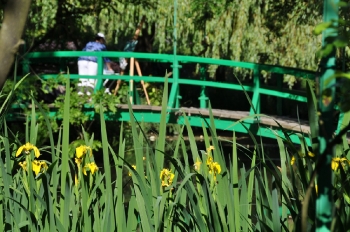 It is many painters’ dream to be able to stay in Monet’s garden to paint.
It is many painters’ dream to be able to stay in Monet’s garden to paint.
If your medium is watercolor, pencils, ink… no problem. Just sit down on a bench (preferably) and paint. But if you use acrylic, for instance, and need an easel therefore, you must ask for allowance. Please get in touch with Fondation Monet. If there aren’t too many requests for the day you wish, you will be granted the privilege of staying in the gardens after closing time. This is the best way to feel just like Monet, almost alone on the grounds. Same vibrations, same inspiration. Have a great time!
Entries Categorized as 'Monet’s flower garden'
Painting Giverny
January 15, 2012
Monet’s Greenhouse
December 21, 2011
 Are you curious to have a look inside of Monet’s greenhouse, that is not open to the public?
Are you curious to have a look inside of Monet’s greenhouse, that is not open to the public?
I was! With the allowance of the gardener, I took this picture last July.
Even in Summer many plants need to be kept inside. Some of them will decorate the house, others will be used to adornate the meeting rooms when VIPs come to Giverny, others are waiting for being planted, others are mother plants…
Monet was such a keen gardener that he built a greenhouse on the location of this one, on the left side of the flower garden. It was heated, and the painter cultivated orchids and exotic ferns. He also grew his seedlings in the greenhouse.
Monet’s Color Garden
November 25, 2011
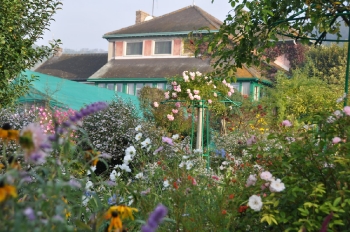 In front of his second studio, a pink house he built in 1899 on the corner of his estate, Monet designed a colorful area of parallel flower beds.
In front of his second studio, a pink house he built in 1899 on the corner of his estate, Monet designed a colorful area of parallel flower beds.
In October, the tall flowers of late season mix their pinks, blues, yellows, oranges and reds and their different textures ans shapes, creating a living painting that moves in the breeze.
Sages, dahlias, asters, cosmos, roses, black eyed Susan, tithonias are all enchanting September and October.
Nasturtiums and Giant Flowers
September 27, 2011
[singlepic id=186 w=350 h=350 float=left]The beauty of September in Monet’s garden at Giverny lies in the bright colors displayed by giant flowers.
Pink or red huge dahlias, tall yellow helianthus, enormous purple asters, supersized yellow or brown sunflowers have now reached their final height.
In the main alley, nasturtiums flow like a river on the sloping ground, pretending to fill the pond of the water garden.
Their petals shimmer in the sunshine, just like paint on an impressionist canvas.
Summertime
August 20, 2011
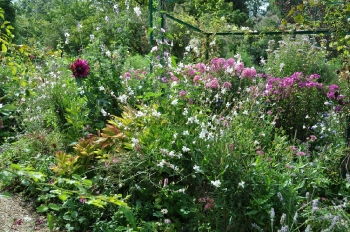 Summer is a gorgeous time in the gardens, especially at Giverny. While water lilies are at their best, the flower garden offers an explosion of colors.
Summer is a gorgeous time in the gardens, especially at Giverny. While water lilies are at their best, the flower garden offers an explosion of colors.
Dahlias in every shapes and shades show their heads among the light butterfly like gauras, phlox and lavenders spread their scents, gladiolis bent graciously over the alleys, surrounded by sages and verbenas. The list of blooming flowers is endless.
Instead of carpeting the ground like in spring, summer flowers stand, tall, imposing and delicate at the same time, offering another experience of the garden.
A Carpet of Flowers
August 1, 2011
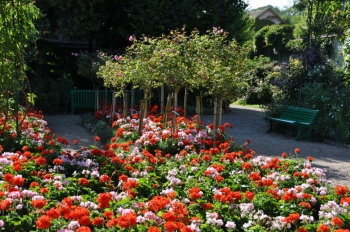 This is one of the most impressive flower beds at Giverny: a vibrant combination of pink and red pelargoniums displayed on oval patterns, just in front of Claude Monet’s house. They look very much like carpets of flowers at the foot of the facade.
This is one of the most impressive flower beds at Giverny: a vibrant combination of pink and red pelargoniums displayed on oval patterns, just in front of Claude Monet’s house. They look very much like carpets of flowers at the foot of the facade.
Pelargoniums, known until recently as geraniums, are the most popular Summer flowers in France. They were my grand mother’s favorite on her windows. No wonder, they are so resistant, easy to grow, long flowering and colorful!
Pelargoniums are commonly used in pots, it is a nice change to plant them in the garden where their rich tones flame in sunny spots.
In Monet’s gardens, they make their come back every year in May just after the last tulips. According to the mood of the gardener, they are planted either by color – an entirely red border and a fully pink one side by side – or mixed like this year. I prefer the latter option. It looks less formal, and more ‘painted’.
A border of pelargoniums in Monet’s garden? It doesn’t sound very exciting. Actually, it is daring. This red and pink carpet surprises many visitors, astonished to encounter such a low and formal flower bed at last, after so many unusual, overgrown mixed borders.
The explanation is the need of contrast. In late Summer, when huge flowers overwhelm visitors meandering along, it is nice to have a corner where you can breath, see in the distance. After the wood, the clearance.
Contrast, one of Monet’s favorite painting trick.
Standard Roses
June 13, 2011
[singlepic id=180 w=350 h=350 float=left]Standard roses are one of the beauties of Giverny.
As tall as trees, they measure over 2 meters and they offer their pink blossom like enormous bouquets.
Rose trees are generally not strong enough to resist wind, so they are grown on metallic structures that look like umbrellas or mushrooms, according to your imagination. Some people call them weeping roses, that’s really too sad.
In Monet’s flower garden, they tower over big bunches of peonies and large flower beds of pink and red poppies.
Pink Blossom at Giverny
April 15, 2011
[singlepic id=178 w=320 h=240 float=left]In the 19th Century, trees used to be white in Spring. There were white blossoms of cherry trees, white plum trees, white pear trees… Apple trees were slightly tinted with pink when budding, but became white when in bloom. Only southern trees like peach or apricot trees could be pink, however they were rarely to be seen in Normandy.
So we can imagine the novelty of introducing exotic varieties like crab apples, Japanese cherry or plum trees in a little village on the countryside like Giverny. Their pink blossom must have looked unique to Monet, and to his neighbours.
The pink exotic trees are widely spread by now, but in April their short beauty still enchants Spring in Claude Monet’s gardens.
The ‘Tulip Fields’ of Giverny
March 12, 2011
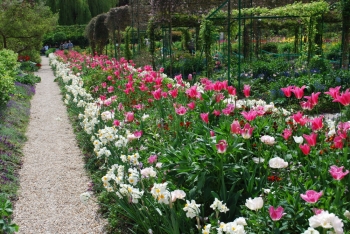 If you are planning a visit to Monet’s garden in Giverny, you may wonder what is the best time of year to come. There are many! The scenery, the flower show change with the seasons. One of my favorite time is the tulip’s.
If you are planning a visit to Monet’s garden in Giverny, you may wonder what is the best time of year to come. There are many! The scenery, the flower show change with the seasons. One of my favorite time is the tulip’s.
Tulips flower mostly during the second half of April. Their blooming is spectacular, gorgeous, breathtaking. They offer colors, colors, colors, always bright ones, they can have soft and tender or very warm flaming tones. They exist in an infinite variety of forms and aspects. And they provide amazing mass effects.
This border, for instance, was designed by Monet after visiting and painting the tulip fields in Holland. He was impressed by the large colorful stripes of these cultures.
When he came back to Giverny, Monet decided he wanted a very long border in his garden, from top to bottom, planted according to a monochromatic scheme.
This oversized flower bed records to his visual experience in Holland, as far as color and size are concerned. But Monet could not be satisfied with one sort of tulips only. His ‘tulip field’ is a very refined mixed border composed of many different sorts of tulips. They harmonize, their pink is slightly different, producing the subtle variation of tones that one can observe on an impressionist painting. A beautiful example of the way Monet used flowers like brushstrokes.
Holly
January 10, 2011
[singlepic=170,320,240,,right]This tree standing alone next to the greenhouse in Monet’s garden at Giverny is a holly.
Not a wild, ordinary one: it has beautiful golden rimmed leaves. Nonetheless, the holly disappears in the magnificence of flowers during the season, when the garden is in full bloom. Nobody takes any notice of the flowerless tree.
During the winter, on the contrary, when all the flowers are dead or waiting for better times to come, the holly recovers its majesty. This is probably why its prickly leaves and red berries are very much related to the time of Christmas and New Year.
A Few Flakes at Giverny
December 12, 2010
[singlepic=168,350,350,,right]It snowed for the second time of the season at Giverny last Wednesday, what is rather unusual so early, at the end of Autumn.
But the gardeners are still working in the garden! They plant the bulbs and pansies for next Spring. Thousands of them. And when the weather is really too cold and snowy, they stay inside and maintain the gardening tools.
Do you recognize on the picture the ladies corner, this round shaped little square under the paulownia, where Mrs Monet and her daughters used to sit down in the afternoon?
Summer Light
September 13, 2010
[singlepic=158,350,350,,left]Summer is coming to an end, offering a large display of flowers in Claude Monet’s gardens at Giverny.
The flower beds that looked organised in early season are now full of overgrown plants, sunflowers, dahlias, cosmos…
Under the clematis, smaller borders catch the morning light dancing on the freshly watered gauras.
The Colors of June
July 4, 2010
[singlepic=154,350,350,,right]In Monet’s garden at Giverny, the month of June is a feast of colors.
In the flower garden turned into a rose garden for a month, weeping roses as big as trees fall from their metallic structure in the shape of a mushroom.
Their pink harmonizes with the blues and purples of the flowers below. A soft match that will last a few days only, before other eye cathing colors appear somewhere else.
A Taste of Heaven
June 3, 2010
[singlepic=153,350,350,,left]Monet’s garden at Giverny is so beautiful at the turn of May and June that it has a taste of Paradise.
In this season, spectacular flowers like irises, paeonies, wallflowers and roses bloom all at the same time.
The small walks of the garden disappear, leaving the illusion of a divine meadow adornated by the most exquisite flowers.
Not to speak about the delicate scent floating in the air…
Paulownia
May 20, 2010
[singlepic=151,350,350,,left]The beautiful lavender blossom of the paulownia in Monet’s flower garden at Giverny harmonizes with the orange azaleas of the water garden, on the other side of the road.
The paulownia blooms exactly at the same time than the lavender wisterias gracing Monet’s Japanese footbridge.
Is it intended or not? What is a coincidence, and what is due to the choices of a clever gardener?
In Monet’s garden, I believe most of the meetings between plants aren’t accidental. Monet, as well as the present day head gardener, was very good at organising dates among the flowers.